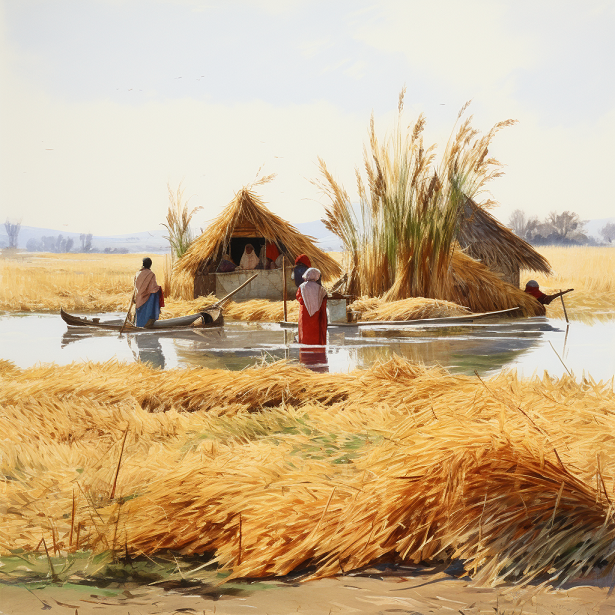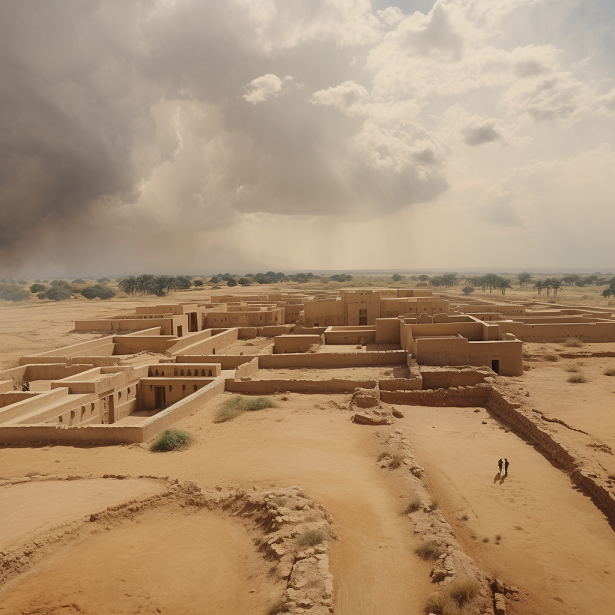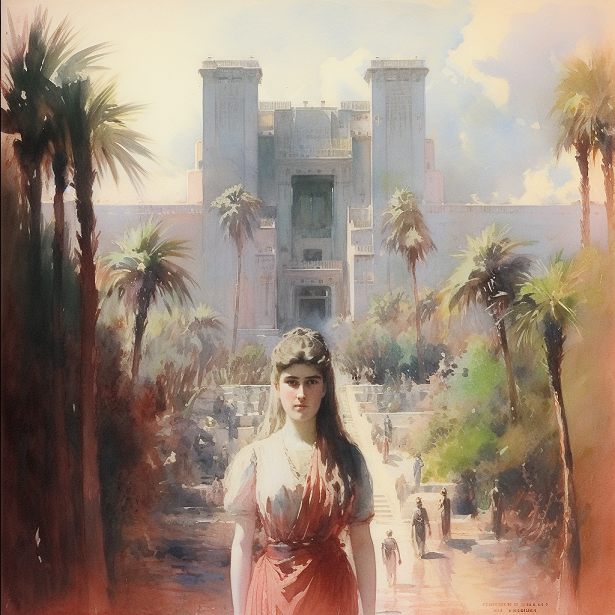Gertrude Bell, a name synonymous with the spirit of adventure and an unparalleled authority on the Middle East, was a prolific traveller of the early 20th century. Her insatiable curiosity led her through the sands and ruins of a region steeped in history, culture, and myth. In 1909, during her journey from Kerbela to Baghdad, Gertrude Bell paused in Babylon, an iconic ancient city that had captured the imagination of scholars and explorers for centuries. Her time in Babylon provided a unique opportunity to witness the remnants of a bygone era and to immerse herself in the historical tapestry of Mesopotamia. In this article, we delve into Bell’s observations and experiences during her sojourn in Babylon, offering a glimpse into her remarkable travels and the profound impact they had on our understanding of this historic land.
Crossing the Euphrates
Gertrude Bell’s journey to the ancient city of Babylon, nestled in the heart of modern-day Iraq, was not just a casual expedition; it was a passage through time. In 1909, this remarkable explorer ventured from Kerbela to Baghdad, an excursion that allowed her to glimpse the storied remnants of Mesopotamia’s past, a region known as the cradle of civilization.
As Bell embarked on her expedition, she encountered the Euphrates River, a waterway that had long been integral to the life and history of the land. However, she noted with amazement that the Euphrates she encountered here was noticeably smaller than the one she had left behind at Hit. This diminution was the result of extensive water diversion into irrigation canals, a testament to the enduring human presence in the area.
One of the striking features of this part of her journey was the ingenious bridge of boats constructed across the Euphrates. It provided Bell and her companions with a practical means to cross the river, an accomplishment that filled them with awe and appreciation for human ingenuity. This bridge was not just a physical connection but a symbol of the persistence of civilization in an area where history, culture, and life had thrived for millennia.
Yet, as Bell moved forward on her path to Babylon, she soon discovered that the challenges she faced were far from over. The journey was not just a tranquil ride along the Euphrates; it was an encounter with a web of intricate irrigation canals and runnels, meticulously engineered by the hardworking fellahin. These channels, often heedless of roads and paths, added a layer of complexity to her expedition, and navigating them became a test of both time and temperament.
Intriguingly, amid these somewhat desolate reflections, Bell’s journey took an unexpected turn as she reached the edges of Babylon. There, on the sun-drenched plain, she spotted a mighty mound that bore a legendary name—Babil. The northern mound, echoing with the ancient title, was a testament to the city’s storied past, and it beckoned Bell to explore further, leaving the road in her quest for a direct path to the great vestiges of ancient splendour.

A Glimpse into Babylon’s Vistas
As Gertrude Bell ventured deeper into the heart of Mesopotamia, she couldn’t help but be struck by the stark transformation of the landscape. What was once a fertile plain, teeming with life, had now become a barren, featureless expanse, with only faint traces of its former glory. This was the very land where the cradle of civilization had once rocked; it had lost its former richness and population, a poignant reminder of the relentless passage of time.
The environment Bell encountered was harsh and unforgiving. Dust storms, carried by the whispers of the winds, would sweep across the horizon, shrouding the land in a sepia haze, and reminding her of the challenges faced by those who chose to inhabit this desolate terrain. The extreme heat, characteristic of the region, was a relentless companion, making her journey an endurance test under the scorching sun. But, in true adventurer’s spirit, Bell pressed on, undeterred by the elements.
One notable feature of this landscape, amidst its desolation, was the prevalence of palm trees. These resilient sentinels of time stood as a testament to the tenacity of life in this harsh environment. Bell marvelled at their ability to thrive in these challenging conditions, offering sustenance and shade to those who called this land home.
For Bell, this dramatic shift in the environment from the fertile plains of Mesopotamia’s past to the stark, arid landscape she was now traversing was not just a mere observation; it was a vivid illustration of the inexorable changes brought by history, climate, and human endeavours. The vibrant history of Babylon had faded into the sands of time, yet its indomitable spirit, manifest in the palm trees that dotted the horizon, lived on—a testament to the enduring power of nature amidst the ever-shifting sands of history.
Babylon and Its Excavation
Gertrude Bell’s journey to Babylon was not just a solitary expedition into the past, but also an opportunity to witness history being unearthed before her very eyes. As a passionate traveller and expert on the Middle East, she had the privilege of visiting the German excavators who toiled tirelessly amidst the ruins of this ancient city.
Among the most remarkable discoveries that Bell bore witness to was the excavation of Nebuchadnezzar’s palace. The grandeur of the Babylonian king’s dwelling was brought to light, revealing its construction techniques, which, even in their antiquity, spoke volumes about the architectural prowess of the time. The palace had been assembled like a giant puzzle, with square tiles and asphalt, each piece contributing to the grand mosaic of Babylonian splendour.
Walking through the labyrinthine layout of the palace, Bell marvelled at the complexity of small courts, chambers, and passages, intertwined in a harmonious architectural dance. Babylon had not just been a city; it had been an intricate tapestry of life, and as the layers of history were peeled away, a clearer picture of this ancient civilization emerged.
The challenges faced by the team of German excavators whom she found there were numerous. Over the centuries, Babylon had been used as a quarry for building materials, depleting its once-majestic structures. This had obscured the understanding of the city’s architectural techniques, particularly regarding roofing. Bell’s keen eye, trained from years of exploration, sought to unravel the enigma of how Babylon’s ancient architects had sheltered its citizens.
As she explored Nebuchadnezzar’s palace, Bell made a fascinating note about a banqueting hall and an emergency exit. These glimpses into the daily life of the Babylonians added an intimate touch to her observations, reminding her that beneath the stones and ruins, this had been a vibrant city filled with stories, feasts, and perhaps the echoes of laughter from a bygone era.
“I went to see the palace on the way. It is a noble pile, with a vast façade, almost Egyptian in its sheer breadth, so much greater is it than it is high. I don’t think that it can be seen properly from the west. There is a great open court in front, and here I found a number of Arabs encamped. In the center of the palace, there is a great open space. There, I understand, the gardens lay. I shall go to see them tomorrow. Here, a complicated arrangement of small courts and chambers. There, passages winding in and out.”
Amurath to Amurath
In the hands of these dedicated German excavators, the sands of time were shifting, slowly revealing the secrets that Babylon had guarded for millennia. These men toiled tirelessly, driven by their love for history and the desire to resurrect the grandeur of the past. Gertrude Bell, with her insatiable curiosity and respect for the Middle East, was but one of many who bore witness to this remarkable endeavour, standing on the precipice of an ancient world that had been dormant, waiting to share its tales.

Ishtar Gate and the Lion Procession
Amid the ruins of Babylon, Gertrude Bell’s keen eye fell upon remarkable structures that transported her back in time to the zenith of this ancient city’s glory. Among these awe-inspiring sights were the Ishtar Gate and the magnificent lion procession that adorned the walls of Via Sacra.
The Ishtar Gate, the imposing entrance to the city, stood as a testament to Babylon’s architectural prowess. Bell marvelled at the rows of bulls and dragons carved in stunning relief. Each detail, each carving, told a story of a civilization that celebrated its might and grandeur, where mythical creatures guarded the city’s heart. The vibrant blue tiles, intricately decorated, were a vibrant testimony to the artistic skill of the Babylonians. As Bell stood before the Ishtar Gate, it was as though she had stepped into the ancient past, and the city walls whispered tales of an empire’s formidable splendour.
The grandeur of Babylon extended beyond its gate and into the very fabric of its streets. Along the Via Sacra, Bell was greeted by a mesmerising lion procession. These mighty creatures, rendered in stone, seemed to be in a timeless parade, forever protecting and celebrating the city. Their presence was a symbol of Babylon’s enduring power, a vivid testimony to the rich tapestry of art and culture that once flourished there.
Civil Unrest, Trust, and the Allure of Ancient Babylon
Gertrude Bell’s expedition to Babylon in 1909 was not without its share of challenges and insights into the turbulent socio-political landscape of the ‘Irak region. While she marvelled at the remnants of an ancient civilization, she also bore witness to contemporary struggles.
The Iraq region simmered with unrest, and the atmosphere bore the potential for revolution. As the German excavators toiled amidst the ruins of Babylon, they grappled with labour issues, compounded by the uncertainty and unrest that gripped the land. The echoes of discontent from the modern world contrasted starkly with the silence of the ancient city.
Yet, amid the backdrop of civil unrest, Bell discovered a resounding theme that had transcended millennia—the values of trust, hospitality, and justice. In the midst of uncertainty and change, the people of Iraq still held dear to their traditions of welcoming strangers, extending their hospitality, and upholding principles of justice. These principles, woven into the very fabric of their society, stood as an enduring legacy of the ancient Babylonians, who had once tread these same paths.
Gertrude Bell’s journey to Babylon was more than just a historical exploration; it was a reminder that amidst the chaos of the modern world, the echoes of an ancient civilization’s values could still be heard. It was a testament to the enduring power of trust, hospitality, and justice.

